It looks like you're using an Ad Blocker.
Please white-list or disable AboveTopSecret.com in your ad-blocking tool.
Thank you.
Some features of ATS will be disabled while you continue to use an ad-blocker.
share:
In my recent post www.abovetopsecret.com... regarding the 20 or so Temples around Mount Hermon and the
connection to 'The Watchers' i noted that many of the worn and battered scavenged stones used in the Roman Temples were of a raised relief boss, or
'pillow' type masonry, including examples found at the summit ruins.
This type of Ashlar masonry in Israel will always get labelled as 'Herodian Masonry', for reasons which i shall make apparant and also challenge.
First we should look at outstanding examples of this masonry style, first at the Temple Mount of Baalbek, then at the Temple Mount of Jerusalem;

So above Baalbek of course, supposedly built by the Romans, with the 'Herodian Masonry' seen at the corner, and below similar found at the Temple Mount, directly attributed to Herod.
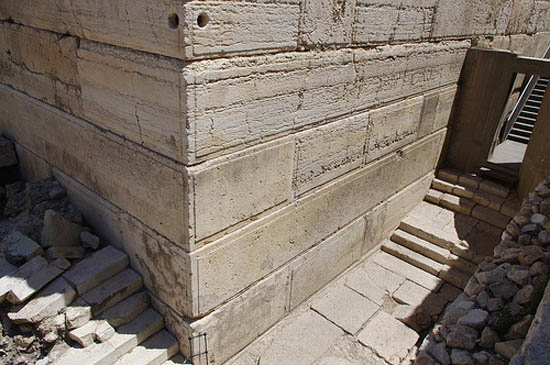
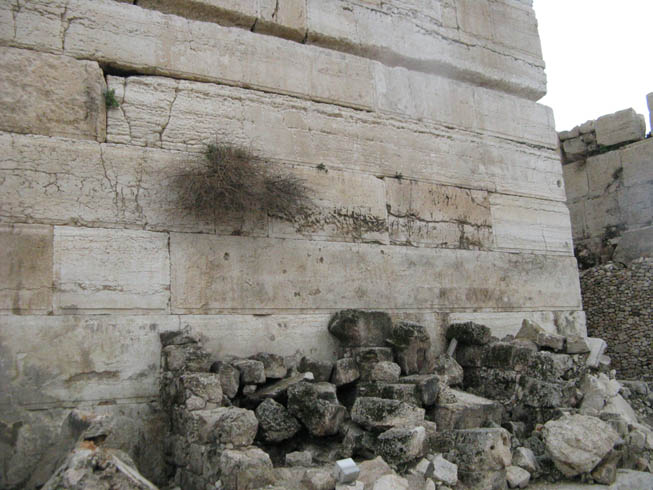
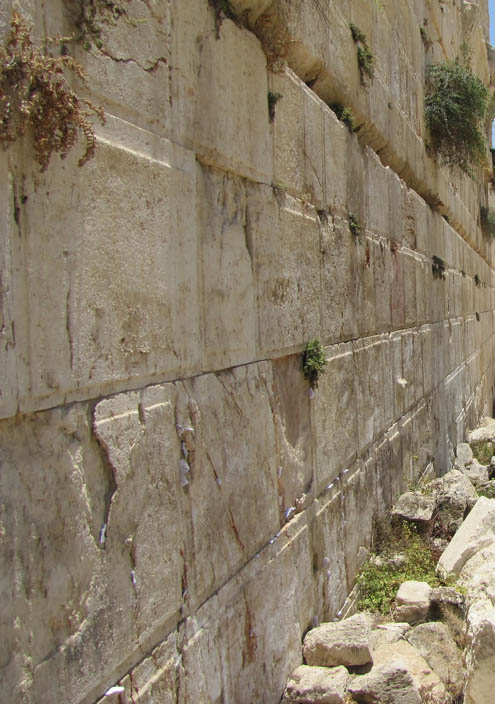
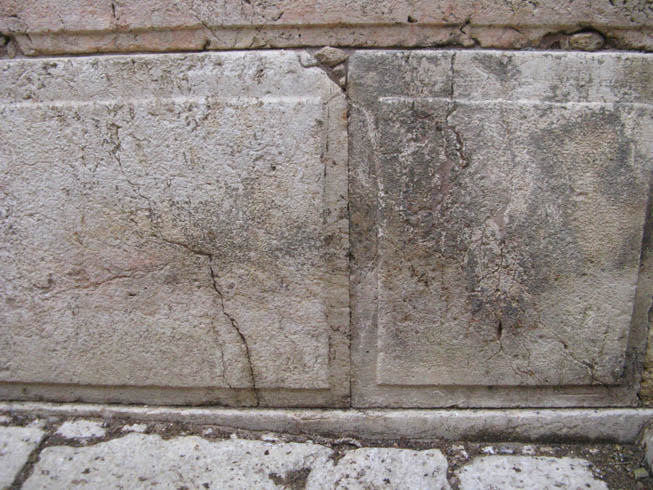

Right away we have a problem with this comparison, Herod certainly didn't construct the Temple Mount at Baalbek, yet the architectural style attributed to him is present there, not to mention all the Temples around Mount Hermon which he wouldn't have gone anywhere near for religious reasons.
This 'problem' is however the coverall explanation for any number of anomalies, for example the circa 600 ton block at the base of the Western wall;
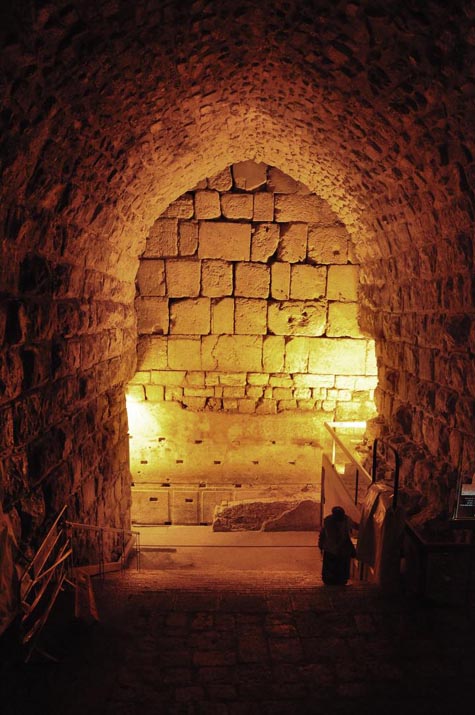
A quick check on the raised relief style and thats understood as Herodian, and those curious rectangular indentations, given as carved in the middle ages to support water cistern architecture, despite examples of the same at Baalbek and all around Mount Hermon scavenged for Roman Temples;
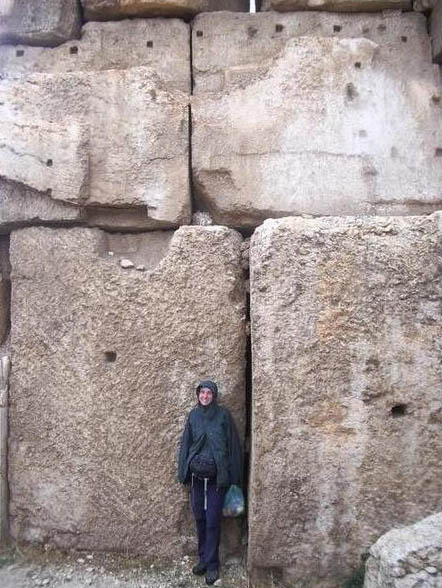
One needs to look at known Herodian sites such as Herodium itself, were he built his Palce and Tomb, and Masada, to see that Herod actually built with modest sized stones, not particularly well carved and without raised relief, even in the prestigious monuments there, which thus lack this 'Herodian Masonry', so with that it mind it might seem easy to propose an earlier origin for that style than Herod and the Romans.
Except at this point one runs into a very large and well constructed stone wall that checks such speculation, this is one other major construction attributed to Herod at Hebron, the enclosure around the Tomb of the Patriarchs.
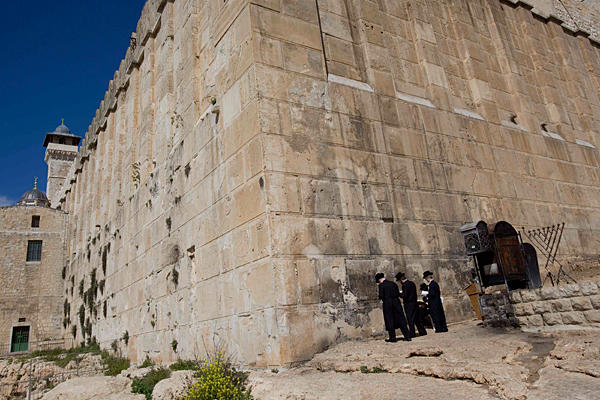
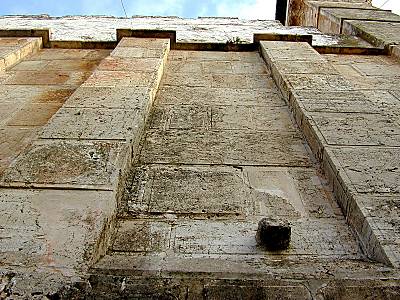
Thus one finds the same manner of stone and construction as at the Temple Mount (and Baalbek) and the circular reasoning is that Herod built the Temple Mount, the same style is found at Hebron, thus Herod also built that, there isn't actually any source linking him to it except for this comparison of style, and as i already mentioned that is not found at well attributed Herodian construction sites, thus all is perhaps not lost.
This is especially so when Josephus writing shortly after the time of Herod in discussing Hebron doesn't mention Herod at all and attributes the monument to the time of Abraham;
Josephus (BJ, IV, ix, 7) speaks of the monuments (mnemeia) of Abraham and his posterity which "are shown to this very time in that small city (i.e. in Hebron); the fabric of which monuments are of the most excellent marble and wrought after the most excellent manner"; and in another place he writes of Isaac being buried by his sons with his wife in Hebron where they had a monument belonging to them from their forefathers
bibleatlas.org...
So curiously Josephus considers the enclosure around a couple of thousand years old in his day, dated to the time of the forefathers of the Patriarchs. The limestone is of very good quality and hard, described as similar to marble, and it certainly withstands the ravages of time well.
The space containing the traditional tombs is a great quadrangle 197 ft. in length (Northwest to Southeast) and 111 ft. in breadth (Northeast to Southwest). It is enclosed by a massive wall of great blocks of limestone, very hard and akin to marble. The walls which are between 8 and 9 ft thick are of solid masonry throughout. .
It's a very curious construction, built seemingly without entrance until one was later forced, i think it does provide the key to understand who constructed similar masonry at the Temple Mounts of Baalbek and Jerusalem, and around Mount Hermon, and i don't think it was Herod, in fact even this explanation would be more likely than that;
Mukaddasi speaks (circa 985) of the strong fortress around the tombs of the patriarchs built of great squared stones, the work of Jinns, i.e. of supernatural beings.
www.israel-a-history-of.com...
However in my opinion these most likely would relate to the Sons of Anak and the Nephilim
Numbers 13:28
"Nevertheless, the people who live in the land are strong, and the cities are fortified and very large; and moreover, we saw the descendants of Anak there."
Numbers 13:31, 33
"But the men who had gone up with him said, 'We are not able to go up against the people, for they are too strong for us.....There also we saw the Nephilim and we became like grasshoppers in our own sight, and so we were in their sight
Joshua 15:13-14
"Now he gave to Caleb the son of Jephunneh a portion among the sons of Judah, according to the command of the Lord to Joshua, namely, Kiriath-arba, Arba being the father of Anak (that is Hebron). And Caleb drove out from there the three sons of Anak: Sheshai and Ahiman and Talmai, the children of Anak.".
The case that can be made from the bible that Hebron was most closely related to the descendants of the Watchers, the Nephilim, or at the very least those who considered themselves such, and thus they would have had a concern with the area around Mount Hermon, and seemingly the Temple Mounts of Jerusalem and Baalbek, and thus may have reconstructed and rebuilt upon even older sites associated with the first 'Watchers'.
Hebron lies less than 20 miles south of Jerusalem. At least three generations of Anakim had been ruling in Hebron prior. Scholars disagree as to the exact length of a generation. To use a conservative, and by no means the exact length, number of forty years as a generation would place the return of the Nephilim at least 120 years prior to the conquest. As Scripture clearly indicates in the following chapters, Canaan is ruled by a number of Nephilim related kings.
Though Hebron was established prior to Abraham, it seems the Nephilim, specifically Arba, had taken control of the city, and claimed it as their capital. At this time, thus, it was known as the city of Arba
If then the enclosure at Hebron dates to some time before the conquest of Caanan by Israel, it would seem probable the Nephilim saw the related caves in a differant context rather than as tombs of the patriarchs, of which there is no mention in Joshua, it being a later post-conquest tradition.
This type of Ashlar masonry in Israel will always get labelled as 'Herodian Masonry', for reasons which i shall make apparant and also challenge.
First we should look at outstanding examples of this masonry style, first at the Temple Mount of Baalbek, then at the Temple Mount of Jerusalem;

So above Baalbek of course, supposedly built by the Romans, with the 'Herodian Masonry' seen at the corner, and below similar found at the Temple Mount, directly attributed to Herod.





Right away we have a problem with this comparison, Herod certainly didn't construct the Temple Mount at Baalbek, yet the architectural style attributed to him is present there, not to mention all the Temples around Mount Hermon which he wouldn't have gone anywhere near for religious reasons.
This 'problem' is however the coverall explanation for any number of anomalies, for example the circa 600 ton block at the base of the Western wall;

A quick check on the raised relief style and thats understood as Herodian, and those curious rectangular indentations, given as carved in the middle ages to support water cistern architecture, despite examples of the same at Baalbek and all around Mount Hermon scavenged for Roman Temples;

One needs to look at known Herodian sites such as Herodium itself, were he built his Palce and Tomb, and Masada, to see that Herod actually built with modest sized stones, not particularly well carved and without raised relief, even in the prestigious monuments there, which thus lack this 'Herodian Masonry', so with that it mind it might seem easy to propose an earlier origin for that style than Herod and the Romans.
Except at this point one runs into a very large and well constructed stone wall that checks such speculation, this is one other major construction attributed to Herod at Hebron, the enclosure around the Tomb of the Patriarchs.


Thus one finds the same manner of stone and construction as at the Temple Mount (and Baalbek) and the circular reasoning is that Herod built the Temple Mount, the same style is found at Hebron, thus Herod also built that, there isn't actually any source linking him to it except for this comparison of style, and as i already mentioned that is not found at well attributed Herodian construction sites, thus all is perhaps not lost.
This is especially so when Josephus writing shortly after the time of Herod in discussing Hebron doesn't mention Herod at all and attributes the monument to the time of Abraham;
Josephus (BJ, IV, ix, 7) speaks of the monuments (mnemeia) of Abraham and his posterity which "are shown to this very time in that small city (i.e. in Hebron); the fabric of which monuments are of the most excellent marble and wrought after the most excellent manner"; and in another place he writes of Isaac being buried by his sons with his wife in Hebron where they had a monument belonging to them from their forefathers
bibleatlas.org...
So curiously Josephus considers the enclosure around a couple of thousand years old in his day, dated to the time of the forefathers of the Patriarchs. The limestone is of very good quality and hard, described as similar to marble, and it certainly withstands the ravages of time well.
The space containing the traditional tombs is a great quadrangle 197 ft. in length (Northwest to Southeast) and 111 ft. in breadth (Northeast to Southwest). It is enclosed by a massive wall of great blocks of limestone, very hard and akin to marble. The walls which are between 8 and 9 ft thick are of solid masonry throughout. .
It's a very curious construction, built seemingly without entrance until one was later forced, i think it does provide the key to understand who constructed similar masonry at the Temple Mounts of Baalbek and Jerusalem, and around Mount Hermon, and i don't think it was Herod, in fact even this explanation would be more likely than that;
Mukaddasi speaks (circa 985) of the strong fortress around the tombs of the patriarchs built of great squared stones, the work of Jinns, i.e. of supernatural beings.
www.israel-a-history-of.com...
However in my opinion these most likely would relate to the Sons of Anak and the Nephilim
Numbers 13:28
"Nevertheless, the people who live in the land are strong, and the cities are fortified and very large; and moreover, we saw the descendants of Anak there."
Numbers 13:31, 33
"But the men who had gone up with him said, 'We are not able to go up against the people, for they are too strong for us.....There also we saw the Nephilim and we became like grasshoppers in our own sight, and so we were in their sight
Joshua 15:13-14
"Now he gave to Caleb the son of Jephunneh a portion among the sons of Judah, according to the command of the Lord to Joshua, namely, Kiriath-arba, Arba being the father of Anak (that is Hebron). And Caleb drove out from there the three sons of Anak: Sheshai and Ahiman and Talmai, the children of Anak.".
The case that can be made from the bible that Hebron was most closely related to the descendants of the Watchers, the Nephilim, or at the very least those who considered themselves such, and thus they would have had a concern with the area around Mount Hermon, and seemingly the Temple Mounts of Jerusalem and Baalbek, and thus may have reconstructed and rebuilt upon even older sites associated with the first 'Watchers'.
Hebron lies less than 20 miles south of Jerusalem. At least three generations of Anakim had been ruling in Hebron prior. Scholars disagree as to the exact length of a generation. To use a conservative, and by no means the exact length, number of forty years as a generation would place the return of the Nephilim at least 120 years prior to the conquest. As Scripture clearly indicates in the following chapters, Canaan is ruled by a number of Nephilim related kings.
Though Hebron was established prior to Abraham, it seems the Nephilim, specifically Arba, had taken control of the city, and claimed it as their capital. At this time, thus, it was known as the city of Arba
If then the enclosure at Hebron dates to some time before the conquest of Caanan by Israel, it would seem probable the Nephilim saw the related caves in a differant context rather than as tombs of the patriarchs, of which there is no mention in Joshua, it being a later post-conquest tradition.
edit on 24-10-2012 by Kantzveldt because: (no reason given)
I can understand why there are no responses to your post yet. It's kind of mind-blowing.
I would love to know the truth behind the Nephilim. It's absolutely the most intriguing part of the OT and other period writings.
Great post! I hope you do more like it.
I would love to know the truth behind the Nephilim. It's absolutely the most intriguing part of the OT and other period writings.
Great post! I hope you do more like it.
fantastic thread and why I follow your stuff. I would normally bypass anything with "nephilim" in the title because it is usually some religious
rant.
/off topic compliment
/off topic compliment
I was just going to do some reading this morning but now you've gone & forced me to log in
Star & flag - amazing thread!
They have always called the area the cradle of civilization - maybe there's more to it than we even acknowledge in the text books.
Star & flag - amazing thread!
They have always called the area the cradle of civilization - maybe there's more to it than we even acknowledge in the text books.
edit on
24-10-2012 by coldkidc because: (no reason given)
Each of those monuments was built during a time when people of the Mediterranean had alphabets and were busy writing literature and keeping records
and sending letters back and forth to each other. We know about Herod the Great's building boom (there were three Herods at this time period, for
those of you who are confused. Herod the Great is confused by some of the later literature with Herod Antipas. However, the letters and documents of
that time do not confuse the three.)
None of the records at the time mention Nephilim, huge people, or magical construction.
In later times, after the empire had fallen into chaos and books and literature weren't widely available (and the people were less literate), the idea that a long time had passed occurs. But at the time of the building of these things, there were no commentaries about magical methods of construction or even of supplies and clothing and houses needed for very tall people.
None of the records at the time mention Nephilim, huge people, or magical construction.
In later times, after the empire had fallen into chaos and books and literature weren't widely available (and the people were less literate), the idea that a long time had passed occurs. But at the time of the building of these things, there were no commentaries about magical methods of construction or even of supplies and clothing and houses needed for very tall people.
reply to post by Byrd
Do you understand you just justified a non technologically advanced civilization that was able to move 1,000 ton blocks?
Really?
Do you understand you just justified a non technologically advanced civilization that was able to move 1,000 ton blocks?
Really?
First we should look at outstanding examples of this masonry style, first at the Temple Mount of Baalbek, then at the Temple Mount of Jerusalem;
So above Baalbek of course, supposedly built by the Romans, with the 'Herodian Masonry' seen at the corner, and below similar found at the Temple Mount, directly attributed to Herod.
Your making a mistake here: The corner view shown here shows the Roman trillithon (the largest blocks) with the Arabic construction over it (circa 600 A.D.) None of this shows the Herodian phase which lies inward of the this view. The Herodian temple podium is nearly identical in style and manner to the Great Temple podium in Jerusalem, of which the Wailing Wall is a remnant of. Both were constructed by Herod.
Drafting and Design. Roman Architectural Drawings and their meanings for the Construction of Heliopolis/Baalbek, Lebanon
Giant Strides towards Monumentality - The architecture of the Jupiter Sanctuary in Baalbek/Heliopolis
Daniel Lohmann (German Archeological Institute, Aachen, Germany Archeologia.beniculturali.it


Kropp and Lohmann: Construction Techniques at Heliopolis and Jerusalem


Dark grey = pre-Roman (Herodian)
Light grey = Roman

Image source: Kropp and Lohmann: Construction Techniques at Heliopolis and Jerusalem
And from A propos du trilithon de Baalbek. Le transport et la mise en oeuvre des mégalithes.
(About the trilithon of Baalbek. Transportation and the implementation of the megaliths.)

Photo credit Jean-Pierre Adam
I'm posting this as any discussion of Baalbek and "Nephalim" is bound to stray into all manner of bad archeology, when the truth is Baalbek was a grand vision by Herod, that never materialized under his rule, but was in fact taken up by the Romans who turned it into their grandest temple. The contribution by earlier cultures to the site came mainly in the form of detritus, resulting in the tel on which Herod built over.
reply to post by Blackmarketeer
Mot really, i'm only concerned with the raised boss relief stones above the trillithon, which would be described as 'Herodian Masonry' in style, they are certainly not Arabic, though others in that wall section above and elsewhere are, but much inferior in style...
If you think they are arabic you would need to be explaining how they also constructed the enclosure at Hebron and the 'Herodian' sections of the Temple Mount, given the similarity in style.
The section involved in the photo you provided is a good example however of what i'm suggesting here, that pre-Roman 'Herodian' i don't think has anything to do with Herod, it's Caananite i'm considering, from before the conquest by Israel.
There is no reason whatsoever King Herod the Great would have constructed at Baalbek.
I'm going to quote you from an earlier thread...
'Anyone who takes the time to read some books on Baalbek will learn that Rome was only the LAST builder at the site, and made extensive use of earlier ruins. Look into the Canaanite temples also built around 1000BC and you'll see the similarities between Baalbek's foundations and those of temples at Tyre and Byblos and even the "wailing wall" of Solomon's temple in Jerusalem
reply to post by Byrd
Yes for example you have Josephus writing shortly after the time of Herod the Great that makes no mention of him constructing at Hebron but rather dates the enclosure to the fore-fathers of Abraham...
The period i'm suggesting for restorations at the Temple Mounts of Baalbek and Jerusalem is pre-conquest Caananite. It really shouldn't matter if you believe in Watchers and Nephilim and strange descents upon Mount Hermon, the important fact is those beliefs were present in the region and informed were and what they constructed.
Herods building boom i know all about having scoured his works for comparisons with Hebron and the Temple Mount...they aren't there...the similarity with those styles is found at Baalbek and around Mount Hermon.
reply to post by WickettheRabbit
Thanks, it is for me interesting to suggest construction and restoration projects involving those who considered themselves descended from the 'Watchers', though i'm not sure how the Jews would react to having their most sacred stones considered as Caanantie/Nephilim, or maybe i am...thanks to everyone for appreciation and interest.
Mot really, i'm only concerned with the raised boss relief stones above the trillithon, which would be described as 'Herodian Masonry' in style, they are certainly not Arabic, though others in that wall section above and elsewhere are, but much inferior in style...
If you think they are arabic you would need to be explaining how they also constructed the enclosure at Hebron and the 'Herodian' sections of the Temple Mount, given the similarity in style.
The section involved in the photo you provided is a good example however of what i'm suggesting here, that pre-Roman 'Herodian' i don't think has anything to do with Herod, it's Caananite i'm considering, from before the conquest by Israel.
There is no reason whatsoever King Herod the Great would have constructed at Baalbek.
I'm going to quote you from an earlier thread...
'Anyone who takes the time to read some books on Baalbek will learn that Rome was only the LAST builder at the site, and made extensive use of earlier ruins. Look into the Canaanite temples also built around 1000BC and you'll see the similarities between Baalbek's foundations and those of temples at Tyre and Byblos and even the "wailing wall" of Solomon's temple in Jerusalem
reply to post by Byrd
Yes for example you have Josephus writing shortly after the time of Herod the Great that makes no mention of him constructing at Hebron but rather dates the enclosure to the fore-fathers of Abraham...
The period i'm suggesting for restorations at the Temple Mounts of Baalbek and Jerusalem is pre-conquest Caananite. It really shouldn't matter if you believe in Watchers and Nephilim and strange descents upon Mount Hermon, the important fact is those beliefs were present in the region and informed were and what they constructed.
Herods building boom i know all about having scoured his works for comparisons with Hebron and the Temple Mount...they aren't there...the similarity with those styles is found at Baalbek and around Mount Hermon.
reply to post by WickettheRabbit
Thanks, it is for me interesting to suggest construction and restoration projects involving those who considered themselves descended from the 'Watchers', though i'm not sure how the Jews would react to having their most sacred stones considered as Caanantie/Nephilim, or maybe i am...thanks to everyone for appreciation and interest.
edit on 24-10-2012 by Kantzveldt because: (no reason given)
edit on 24-10-2012 by Kantzveldt because: (no reason
given)
edit on 24-10-2012 by Kantzveldt because: (no reason given)
edit on 24-10-2012 by Kantzveldt because: (no
reason given)
Question.
When the nephilim eventually show themselves, return to power once more and reign over this world. Who is willing the obey orders from these once fallen demi-gods or angel/human hybrids ?
When the nephilim eventually show themselves, return to power once more and reign over this world. Who is willing the obey orders from these once fallen demi-gods or angel/human hybrids ?
reply to post by Kantzveldt
You claim in your OP that the 'Herodian masonry' as seen as part of the temple mound at Baalbek is not actually Herodian. But the fact is, it is Herodian, as Lohmann has extensively surveyed the site and determined. He depicts in his reports with great care the extent of the Herodian temple podium, as distinct from the Roman construction and the later Arab fortifications. For the record, AFAIK the Arabs did reuse much of the stone from the ruined temple, and in your top image, ALL the stone from the trillithon up is placed there by the Arabs circa 600 AD - in fact that stone work was removed in the early 20th C. by the DAI, who excavated and surveyed the underlying structure (including exposing a Roman-etched full-scale drawings of the Jupiter temple's pediment), then reconstructed. You end up with a real mixture of masonry - Roman, Herodian, and Arab.
Herod engaged in a lot of building in his reign. It may have been motivated by his less-than-legitimate claim to the throne as king of Judea. He built the Great Temple in Jerusalem, and it made him a lot of money, and consolidated Judeans hold in the region. Building a similar themed temple out in the sticks like Baalbek may have been an attempt at extending his (and Judean's) influence as well as the opportunity it presented to make more money.
You claim in your OP that the 'Herodian masonry' as seen as part of the temple mound at Baalbek is not actually Herodian. But the fact is, it is Herodian, as Lohmann has extensively surveyed the site and determined. He depicts in his reports with great care the extent of the Herodian temple podium, as distinct from the Roman construction and the later Arab fortifications. For the record, AFAIK the Arabs did reuse much of the stone from the ruined temple, and in your top image, ALL the stone from the trillithon up is placed there by the Arabs circa 600 AD - in fact that stone work was removed in the early 20th C. by the DAI, who excavated and surveyed the underlying structure (including exposing a Roman-etched full-scale drawings of the Jupiter temple's pediment), then reconstructed. You end up with a real mixture of masonry - Roman, Herodian, and Arab.
Herod engaged in a lot of building in his reign. It may have been motivated by his less-than-legitimate claim to the throne as king of Judea. He built the Great Temple in Jerusalem, and it made him a lot of money, and consolidated Judeans hold in the region. Building a similar themed temple out in the sticks like Baalbek may have been an attempt at extending his (and Judean's) influence as well as the opportunity it presented to make more money.
reply to post by Blackmarketeer
It may be the case as you say that it has latterly been reconstructed from scavenged stone, but my general point and you would probably agree is that it is what is considered as 'Herodian Masonry', in my opinion Caananite.
There is no possibility of Herod having built at Heliopolis/Baalbek as it was outside his Kingdom in the Roman Province of Syria, as were all the Temples around Mount Hermon which i have drawn attention to has having similar scavenged masonry in their construction, given that and the religious associations of the site it's way beyond unlikely to the extent of inconcievable.
Again it all comes back to my main point that what is considered as Herodian style masonry isn't, it's Caananite and at least a thousand years older, Lohmann obviously doesn't question this identification based on the association of the Temple Mount and Hebron, disregarding Masada, Herodium and elsewhere, doesn't consider why 'Herodian Masonry' is built into Roman Temples of Mount Hermon, looking considerably older than original Roman.
It may be the case as you say that it has latterly been reconstructed from scavenged stone, but my general point and you would probably agree is that it is what is considered as 'Herodian Masonry', in my opinion Caananite.
There is no possibility of Herod having built at Heliopolis/Baalbek as it was outside his Kingdom in the Roman Province of Syria, as were all the Temples around Mount Hermon which i have drawn attention to has having similar scavenged masonry in their construction, given that and the religious associations of the site it's way beyond unlikely to the extent of inconcievable.
Again it all comes back to my main point that what is considered as Herodian style masonry isn't, it's Caananite and at least a thousand years older, Lohmann obviously doesn't question this identification based on the association of the Temple Mount and Hebron, disregarding Masada, Herodium and elsewhere, doesn't consider why 'Herodian Masonry' is built into Roman Temples of Mount Hermon, looking considerably older than original Roman.
Another great piece of work and thanks for sharing.
I`m fascinated by the tales of the Nephilim.
Really dig your work !
I`m fascinated by the tales of the Nephilim.
Really dig your work !
i find this thread rather interesting
so i'm just posting to keep up with it easier...
interesting thoughts on both sides.
so i'm just posting to keep up with it easier...
interesting thoughts on both sides.
I don't know if we will ever actually know who originally built what, when, and what those after reused or built on top of as I am afraid the truth
and details have been lost to history. I truly believe that all theories when it comes to these ancient cultures and architecture are just that
theories as civilizations have a habit of writing there own interpretation of events and their own "history"
Originally posted by Kantzveldt
reply to post by Blackmarketeer
It may be the case as you say that it has latterly been reconstructed from scavenged stone, but my general point and you would probably agree is that it is what is considered as 'Herodian Masonry', in my opinion Caananite.
I would side with Phoenician or Caananite myself, but then I cannot counter Lohmann's expertise
There is no possibility of Herod having built at Heliopolis/Baalbek as it was outside his Kingdom in the Roman Province of Syria, as were all the Temples around Mount Hermon which i have drawn attention to has having similar scavenged masonry in their construction, given that and the religious associations of the site it's way beyond unlikely to the extent of inconcievable.
If Phoenician or Caananite that solves the Roman 'province' problem since those guys were building way before the Roman's popped up
edit on 24/10/12 by Hanslune because: (no reason given)
Originally posted by JrDavis
reply to post by Byrd
Do you understand you just justified a non technologically advanced civilization that was able to move 1,000 ton blocks?
Really?
They didn't move the 1,000 tonners they moved the smaller trilitons which weighted between 650 and 800 tons - sources vary on the estimates. The big guys were left in the quarry
reply to post by Kantzveldt
Some of those blocks weigh 2 million pounds, no way a normal sized team of men could move something like that much less lift it into place, especially with the type of technology they had back then.
Some of those blocks weigh 2 million pounds, no way a normal sized team of men could move something like that much less lift it into place, especially with the type of technology they had back then.
Originally posted by Rapha
Question.
When the nephilim eventually show themselves, return to power once more and reign over this world. Who is willing the obey orders from these once fallen demi-gods or angel/human hybrids ?
Return? They never left, theyre chained up underground somewhere, imprisoned until the final judgement. Heylel is the only one that didn't get chained up, that's what Jacob's Trouble is about. He gets thrown down to earth and starts trying to take over.
reply to post by Kantzveldt
Kantzveldt. You are THE MAN.
My very favourite topic OF ALL TIME.
I completely agree with you, and I'm so glad your research is leading you into this avenue.
It's proclaimed in the OT (Isaiah 13 I think) by the 'Lord of Hosts' that he controls an army of giants, from a land afar off, from the utmost foundation of heaven, and that they were coming to destroy the world. This particular story is referring to the prophecy of the destruction of Babylon, if I remember correctly.
Sounds to me like an army of giants from another planet.
Keep up the good work. I will watch your progress closely. Thank you for your time.
Kantzveldt. You are THE MAN.
My very favourite topic OF ALL TIME.
I completely agree with you, and I'm so glad your research is leading you into this avenue.
It's proclaimed in the OT (Isaiah 13 I think) by the 'Lord of Hosts' that he controls an army of giants, from a land afar off, from the utmost foundation of heaven, and that they were coming to destroy the world. This particular story is referring to the prophecy of the destruction of Babylon, if I remember correctly.
Sounds to me like an army of giants from another planet.
Keep up the good work. I will watch your progress closely. Thank you for your time.
reply to post by LightAssassin
Isaiah 13 does not say he comes to destroy the earth, he comes to punish evil men.
Isaiah 13 does not say he comes to destroy the earth, he comes to punish evil men.
new topics
-
What is the white pill?
Philosophy and Metaphysics: 17 minutes ago -
Mike Pinder The Moody Blues R.I.P.
Music: 1 hours ago -
Putin, Russia and the Great Architects of the Universe
ATS Skunk Works: 4 hours ago -
A Warning to America: 25 Ways the US is Being Destroyed
New World Order: 8 hours ago
top topics
-
President BIDEN's FBI Raided Donald Trump's Florida Home for OBAMA-NORTH KOREA Documents.
Political Conspiracies: 14 hours ago, 31 flags -
A Warning to America: 25 Ways the US is Being Destroyed
New World Order: 8 hours ago, 14 flags -
Is AI Better Than the Hollywood Elite?
Movies: 15 hours ago, 4 flags -
Mike Pinder The Moody Blues R.I.P.
Music: 1 hours ago, 2 flags -
Maestro Benedetto
Literature: 15 hours ago, 1 flags -
Putin, Russia and the Great Architects of the Universe
ATS Skunk Works: 4 hours ago, 1 flags -
What is the white pill?
Philosophy and Metaphysics: 17 minutes ago, 1 flags
active topics
-
President BIDEN's FBI Raided Donald Trump's Florida Home for OBAMA-NORTH KOREA Documents.
Political Conspiracies • 23 • : xuenchen -
Gaza Terrorists Attack US Humanitarian Pier During Construction
Middle East Issues • 62 • : CarlLaFong -
Meadows, Giuliani Among 11 Indicted in Arizona in Latest 2020 Election Subversion Case
Mainstream News • 17 • : network dude -
New whistleblower Jason Sands speaks on Twitter Spaces last night.
Aliens and UFOs • 69 • : Ophiuchus1 -
Putin, Russia and the Great Architects of the Universe
ATS Skunk Works • 16 • : CristianVictoria -
Alternate Electors vs Fake Electors - What is the Difference.
2024 Elections • 123 • : frogs453 -
Massachusetts Drag Queen Leads Young Kids in Free Palestine Chant
Social Issues and Civil Unrest • 17 • : ToneD -
Hate makes for strange bedfellows
US Political Madness • 51 • : network dude -
The Acronym Game .. Pt.3
General Chit Chat • 7755 • : F2d5thCavv2 -
What is the white pill?
Philosophy and Metaphysics • 0 • : kwaka
